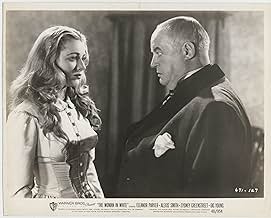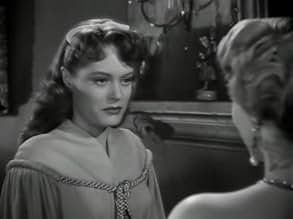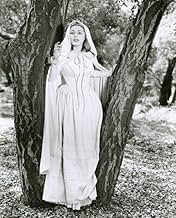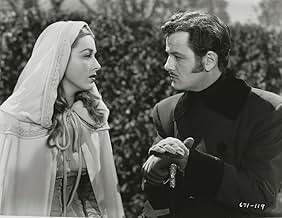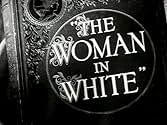Füge eine Handlung in deiner Sprache hinzuA ghostly woman warns a beautiful Victorian heiress about a count, and a strange spell haunts a mansion and its inhabitants in an adaptation of Wilkie Collins' novel.A ghostly woman warns a beautiful Victorian heiress about a count, and a strange spell haunts a mansion and its inhabitants in an adaptation of Wilkie Collins' novel.A ghostly woman warns a beautiful Victorian heiress about a count, and a strange spell haunts a mansion and its inhabitants in an adaptation of Wilkie Collins' novel.
- Regie
- Drehbuch
- Hauptbesetzung
- Auszeichnungen
- 3 wins total
- Attendant
- (Nicht genannt)
- Station Agent
- (Nicht genannt)
- Young Boy
- (Nicht genannt)
- Underservant
- (Nicht genannt)
- Mourner
- (Nicht genannt)
Empfohlene Bewertungen
Except for a few grotesque close-ups of Greenstreet, director Godfrey films the scenes in straightforward fashion, as though they come straight from the pages of the Collins book. Thanks, however, to Warner's art department and set designer, the visuals come across as generally atmospheric and evocative of the period. Nonetheless, someone should have told composer Max Steiner that not every scene needs scoring, especially when the notes sound as if they thunder from the bottom of a well. Then too, the script should have made better use of the great Agnes Moorehead (just count her lines), one of the few actresses with enough gravitas to go toe-to-toe with the formidable Greenstreet. You just know at first glance, she's no one to mess with.
Somehow, I kept wishing Val Lewton ("Cat People", "Seventh Victim") had gotten hold of the material first. This movie could have used his eye for combining the literary with the uncanny, which would go beyond atmosphere to cast a much-needed hypnotic spell, particularly in Anne's outdoor scenes (the actual woman in white). As things stand, the movie's an okay entertainment, with a chance to view some of Warner's leading contract players, circa 1948.
They only partly succeed, due mainly to Greenstreet's histrionic finesse as Count Fosco, seething with villainous intentions and stealing every scene he's in. Eleanor Parker, even though she has a dual role, gives one of her weaker performances as the dull heroine Laura and is only slightly more interesting in the title role. Gig Young is handsome as her suitor but looks a bit uncomfortable in his costume role.
If you like Gothic romance, you'll find plenty to admire here, especially the low-key lighting, the costumes, the quietly menacing music and the overall atmosphere of this period piece. But the resolution differs from the novel and goes for an artificially contrived happy ending.
Trivia note: When the film was released, the poster art showed all the actors in modern costumes to disguise the fact that the story took place in Victorian times. Warner Bros. frequently misled their audiences in this manner, particularly with films like DEVOTION (the Bronte sisters) showing the actresses in modern dress.
It loses steam about 2/3 of the way in and climaxes a little clumsily, but on balance this is an above average effort with much to recommend it.
Our heiress Laura Fairlie and the mysterious Woman In White are both played by Eleanor Parker. Almost up to the end I had trouble figuring out exactly what the relationship was between the two Eleanors so I will not say. It's half the fun of watching the film.
There's a pair of villains in the piece Sidney Greenstreet playing Count Fosco, playing him with the same avuncular malice as Casper Guttman. He's a scientist with a title like Baron Von Frankenstein. But rather than experimenting with dead bodies, Fosco prefers to work on the mind with chemicals and intimidation. He's getting a big payoff for arranging the marriage between Parker the heiress and a rapacious no account count John Emery. The only friend the heiress has in the house is companion Alexis Smith.
My favorite in the film is John Abbott who is Parker's father who has the constitution of a napkin and makes Adrian Monk look hale and hearty with all his phobias. Greenstreet and Emery intimidate him rather easily.
Second favorite is Agnes Moorehead who is the countess Fosco and with very little dialog, but much facial expression is the picture of a woman scorned.
This Victorian Gothic drama has one fine cast of scene stealers all working overtime for your enjoyment. The end is unforgettable.
Wusstest du schon
- WissenswertesWilkie Collins' 'The Moonstone', published in 1868, is considered to be the first modern mystery employing a crime-detecting hero.
- PatzerThe first time Ann visits Laura in her sick bed (a composite shot, as Eleanor Parker is playing both roles), her shadow is visible on the headboard. Her shadow is not synced with her head movements while talking; it rises and moves away moments before Ann herself does. Apparently, the attempt to 'imitate' Ann's shadow on Laura's half of the shot didn't quite get the timing right.
- Zitate
Count Alessandro Fosco: Your proposal doesn't surprise me. Like a good general, you admit defeat when it's a fact. You're bold, you're logical. My dear, you're immensely tempting.
Marian Halcombe: Please Count Fosco, can you not say yes or no?
Count Alessandro Fosco: Let me see then. You suggest I take my ill got gains, free and then abandon my precious wife.
Marian Halcombe: Precious? The day you do so will be the day of her deliverance.
- VerbindungenReferenced in The Toxic Avenger: The Musical (2018)
Top-Auswahl
Details
- Erscheinungsdatum
- Herkunftsland
- Sprache
- Auch bekannt als
- La mujer de blanco
- Drehorte
- Produktionsfirma
- Weitere beteiligte Unternehmen bei IMDbPro anzeigen
- Laufzeit1 Stunde 49 Minuten
- Farbe
- Seitenverhältnis
- 1.33 : 1


